The Mixed Culture
Travel stories and culture learned.


Parol: A symbol of Filipino Christmas Spirit
Filipino Christmas celebration is colorful, lively, full of traditions, bright and definitely twinkling. One of the most iconic symbol of Filipino Christmas spirit, is the Christmas lantern or locally known as “paról”. The star-shaped lanterns are displayed hanging outside the house, along the busy streets of the cities and even in provincial towns and small villages. May it be a parol with simple or intricate designs, for Filipinos it is an expression of shared faith and hope. It also symbolizes the triumph of light over darkness and Filipinos’ goodwill during Christmas season.
For Filipinos, it is a known belief that parol making and hanging them outside their homes is a representation of the star of Bethlehem that guided the Three Wise Men to the manger of baby Jesus. However, if we’ll look at the history of paról it can be traced back during the Spanish era in the Philippines, when the Spaniards brought Christianity to the islands. Parols were initially used to light the way to church to faithfully attend the 9-day Simbang Gabi or Misas de Aguinaldo, that begins on the 16th of December, a devotion for petition of special favors. After coming home from hearing the mass, instead of putting away the lantern somewhere else, people would hang it outside the house.

The real origin of the Filipino “Parol” can be linked to the Mexican “luminaria” or clay-pot lantern placed outside the window during the El Posada, when villagers re-enact Joseph and Mary’s journey to Bethlehem in search of a room to deliver the baby Jesus. When we had our Simbang Gabi during the Spanish times, our ancestors placed a lantern made of bamboo and Japanese paper with a tail made of paper outside their windows, as the town priest would knock on every door from one end of the village to the church. The parol symbolizes that their home is open and ready to receive Jesus Christ (as we know the 9-day novena masses represents the 9 months Christ was in Mary’s womb), also, it symbolizes that they are awake and ready to join the procession towards the church. The people walking carries a bamboo with the Star lantern to light their way- and this is closer to the Star of Bethlehem metaphor.

Comparing to the modern representation of parol and its historical origin, the audience for the Parol is the unborn Jesus Christ himself along with Mary and Joseph, instead of the Three Kings.

Paróls are lanterns and traditionally made of bamboo, papél de japón (Japanese paper) and illuminated with candle or kalburo (carbide). As times goes by, the lantern evolved into a more intricate, lavish and brightly lit Christmas ornament. Aside from the traditional design of parols, other materials are used such as capiz shells with elaborate lights became popular too. Adding to the meaning of parol, the lantern also demonstrates the craftsmanship of Filipinos. Many communities, such as villages, schools, and groups hold competitions to see who can make the best paról. In the province of Pampanga, an annual Giant Lantern Festival is held, which attracts various craftsmen from across the archipelago.
Yuletide season is definitely bright and twinkling in the Philippines, no wonder with the paról, it became the Festival of Lights. To appreciate and see the peak of the Festival of Lights in the Philippines, one must travel at night from December 16th up to January 6th. All kinds of paróls will make your holidays merrier and bright. Filipinos’ Christmas lantern, a tradition, an art and an emblematic symbol of Christmas.
If you enjoyed the bits of information about the meaning of Parol, and wants to read more from The Mixed Culture, make sure to subscribe to my mailing list to read my latest blog straight from your inbox. Or, follow me on Facebook or Instagram for the latest scoop from me. Feel free to email me for any questions or comment below.
Con mucho amor,
Share this:
44 thoughts on “ parol: a symbol of filipino christmas spirit ”.
- Pingback: 31 Christmas Traditions Around The World You Can Do At Home - Indigo Sahara
- Pingback: ‘From Our Family to Yours’ Shows the Magic of the Holidays
- Pingback: First Parol Fest in Temecula celebrates Asian American culture for a cause – Press Enterprise – basternae
- Pingback: 90 Christmas Traditions Around the World (w/ Fun Christmas Facts) - Live Dinero
- Pingback: 5 Christmas Traditions/Celebrations From Around The World
- Pingback: Paper Traditions From Around The World | Love Paper
- Pingback: Watercolor paintings: Filipino Christmas/Holiday Lanterns
- Pingback: 80 Christmas Traditions Around the World (with Fun Christmas Facts) - Currant news
- Pingback: 80 Christmas Traditions Around the World (with Fun Christmas Facts) – Mouqtasid
- Pingback: Incredible 80 Christmas Traditions Around the World (with Fun Christmas Facts) - News Adventure
- Pingback: 80 Christmas Traditions Around the World (with Fun Christmas Facts) - Easy2book
- Pingback: 75 Christmas Traditions Around The World - Jandaiatrip
- Pingback: 80 Christmas Traditions Around the World (with Fun Christmas Facts) - THE WALDEN POST
- Pingback: 75 Christmas Traditions Around the World (with Fun Christmas Facts)
- Pingback: A Quick Look at Christmas Traditions Around the World - Revivalist
- Pingback: Christmas in the Philippines: What Christmas Means to Me - Outspoken
- Pingback: PHOTOS OF THE WEEK: Christmas around the World: – 123PhotoGo
- Pingback: Parol - The Christmas Filipino Star Lantern | Tamrah Lane
- Pingback: 21 photos that show how Christmas is celebrated around the world – Warta Saya
- Pingback: A Traditional Christmas Care Package for Wednesday, Dec. 15, 2020 – EthanDezotelle.com
- Pingback: Spotlight on Geography - a Filipino Christmas - Charlotte Mason Institute
- Pingback: Daily Light – Dec 7, 2020 – Let There Be Light
- Pingback: Making Space for a Multicultural Christmas – Michelle Reyes – Uncaged Lion
- Pingback: Making Space for a Multicultural Christmas – ChriSoNet.Com
- Pingback: Making Space for a Multicultural Christmas - The Kingdom Guard
Hi po Ms. Imelda,
Thank you for writing and sharing this po! The information you wrote is super helpful as I research the parol for a story I’m writing. I will tag you as well and provide your website’s link if that is alright.
Happy Christmas po!
With love and big smiles,
I’m glad that it will help you in some sort related to your work Yes, feel free to tag me. All the best!
- Pingback: Parol – Official website of bulalordyt
- Pingback: Christmas Food around the Globe (Part 2) - The Fearless Olive
Thank you for promoting Filipino culture. I have to write to you though to correct the wrong assumption that the Parol originated as a symbol of the Star of Bethlehem. That has been propagated as a myth, but is historically incorrect.
The real origin of the Filipino “Parol” is the Mexican “luminaria” or clay-pot lantern placed outside the window during the El Posada, when villagers re-enact Joseph and Mary’s journey to Bethlehem in search of a room to deliver the baby Jesus. When we had our Simbang Gabi during the Spanish times, our ancestors placed a lantern made of bamboo and Japanese paper with a tail made of paper outside their windows, as the town priest would knock on every door from one end of the village to the church. The parol symbolizes their home is open and ready to receive Jesus Christ (as we know the 9-day novena masses represents the 9 days Christ was in Mary’s womb), also symbolizes they are awake and ready to join the procession towards the church. The people walking carries a bamboo with the Star lantern to light their way- and this is closer to the Star of Betlehem metaphor.
But in reality- it is the luminaria. The earliest Parols did not have a star, just a box lantern with a tail.
Thus the audience for the Parol is the unborn Jesus Christ himself along with Mary and Joseph, instead of the Three Kings or Santa Claus. See the difference?
Correction…..9 months inside Mary’s womb.
- Pingback: A Quick Look at Christmas Traditions Around the World - The Drifter Collective
- Pingback: How Christmas is celebrated in 21 places around the world | Business Insider
- Pingback: Christmas! How does the WORLD celebrate? | We Luv Christmas!
- Pingback: How Christmas is celebrated in 21 places around the world - CihCih
Hello Imelda,
We decorate our cubicles at work, and my mom got me some mini-parols from PI, so I’ve put them up! I’ll be using some of your descriptions to share with my co-workers, to provide a little holiday cheer and Filipino knowledge.
Many thanks and Maligayang Pasko from Los Angeles!
That’s so nice and keep Filipino tradition alive!. Go ahead and let me know what’s your colleagues thought about them. Share some pictures!
Cheers and Maligayang Pasko from Montreal! 🙂
Warmest regards, Imelda
the article is so timely specially Christmas is approaching… thank you for the info.. it catches my attention to read it till the end.. may i ask permission to read some lines of your article to relay to others on why we have parol during Christmas. thank you.
Thank you for reading it. Sure go ahead and share it. That’s the reason why I wrote it, to let others know the meaning of parol as many forget or dont’t it especially the new generation.
- Pingback: Autotelic, Ebe Dancel Sing in Coke Studio PH Holiday Special
- Pingback: Christmas Around The World | The Perpetual Preschool
Hi there! I own a travels and tours company and our Facebook page will be featuring 95 facts about the Filipino Christmas. I got some insights from your article, and I just want to let you know that you’ll be tagged soon when the “parol fact” is posted. To check the post out, you can like our page. It’s http://www.facebook.com/lakwatserahandbook . Thanks!
hello!thank you for letting us know. so exciting! sure go ahead! 🙂 and feel free to tag us anywhere 🙂 I also have a FB page if you want to tag it as well…so TAG it away!!! Good luck and if there’s anything you see in my site that is useful for you, feel free to use them all 🙂
Much appreciation, Imelda
- Pingback: I said “It’s Okay” | The Online Journal
Your feedbacks are highly appreciated. Drop us some notes. Cancel reply
This site uses Akismet to reduce spam. Learn how your comment data is processed .

- Already have a WordPress.com account? Log in now.
- Subscribe Subscribed
- Copy shortlink
- Report this content
- View post in Reader
- Manage subscriptions
- Collapse this bar

A symbol of Filipino Christmas: Looking back at the history of Parol
- Facebook Data not found. Please check your user ID. Twitter You currently have access to a subset of X API V2 endpoints and limited v1.1 endpoints (e.g. media post, oauth) only. If you need access to this endpoint, you may need a different access level. You can learn more here: https://developer.x.com/en/portal/product Instagram Please check your username.
- Now Week Month

Our traditions for celebrating Christmas indeed have significance together with its historic value. Filipino Christmas celebrations are vibrant, vivacious, stuffed with customs, cheery, and undeniably dazzling. One of the causes is the Christmas lantern, also known as parol, which is the most iconic symbol of the Filipino Christmas spirit. Usually displayed outside of homes, along busy city streets, in tiny villages, and in provincial towns are these star-shaped lanterns.
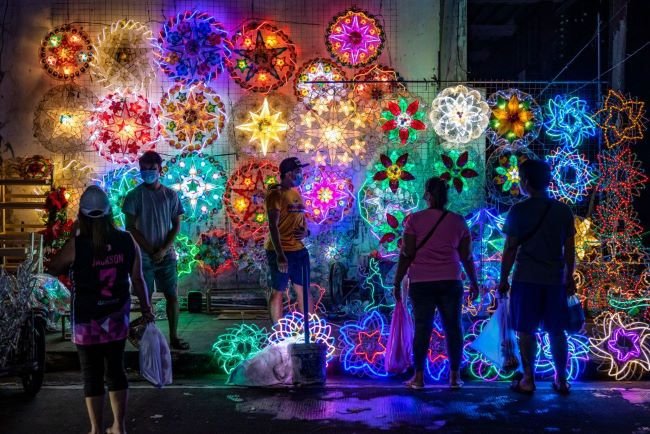
It is a representation of a unifying faith and hope. It also represents people’s unified celebration of kindness throughout the Christmas season and represents the triumph of light over darkness. Likewise, encouragement and hope can be present to Filipinos throughout this pandemic by lighting parols and hanging Christmas ornaments. Let’s take a look at how parol evolved into the distinctive Filipino Christmas symbol it is today.
Reminiscing the history of parol
Spanish times.
When the Spanish colonized the Philippines and introduced Christianity to the region, the parol first appeared then. The Spanish term “farol,” which means lantern, is now spelled “paról” in Filipino. However, the parol served as more than just decoration during the Spanish era.
Our ancestors put a parol outside their windows when we celebrated our Simbang Gabi during the Spanish era because the town priest would knock on every door from one end of the village to the church. As we know from the 9-day novena masses, which reflect the nine months Jesus Christ spent in Mary’s womb, the parol represents that people’s home is open and prepared to receive Jesus Christ. Additionally, it signifies that they are awake and prepared to join the procession to the church.

This metaphor is closer to the Star of Bethlehem because the folks walking carry bamboo along with the parol to light their path. Moreover, the Panunulyan procession recreates Joseph and Mary’s journey to Bethlehem in quest of a place to give birth to the baby Jesus. While carrying a parol, the performers portray Joseph and Mary as well as the residents of the town.
Later, these lanterns served as decorations after the parade, hanging outside homes. However, only for the Christmas Novena procession, the parol should be used. During other Novena processions in the Philippines, participants carry lit candles in their instead.
The design during the 1800s
White paper in plain rectangular or oblong shapes was used to make the first parols during the early Spanish era. Candles or lamps made of coconut oil lit them. Standardization of the parols’ shapes and placement used in Pampanga’s traditional Lubenas processions, which date back to the 1800s. A fish-shaped parol with hinged jaws (called the asan) representing Ichthys follows a cross-shaped parol at the front of the procession, which stands for Jesus. The andas (shoulder-borne palanquin) or carroza (wheeled chariot), which carries holy images, are behind them.
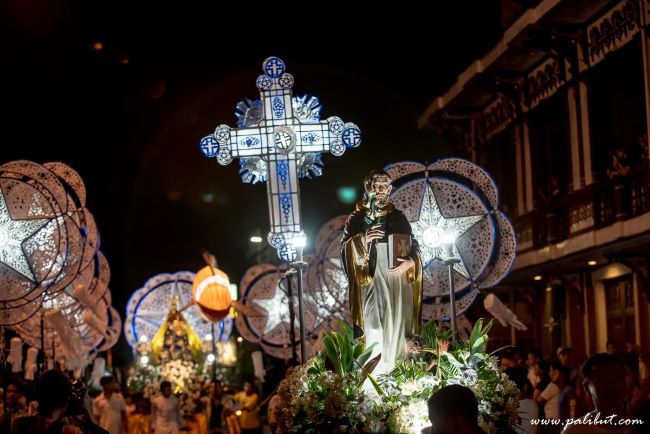
There are a total of twelve star-shaped parols, one for each of the twelve apostles, arranged in two rows on either side of the carriages. The giant, finely built lantern behind the carriage inspired the creation of the Giant Lantern Festival . This giant lantern can appear in any shape.
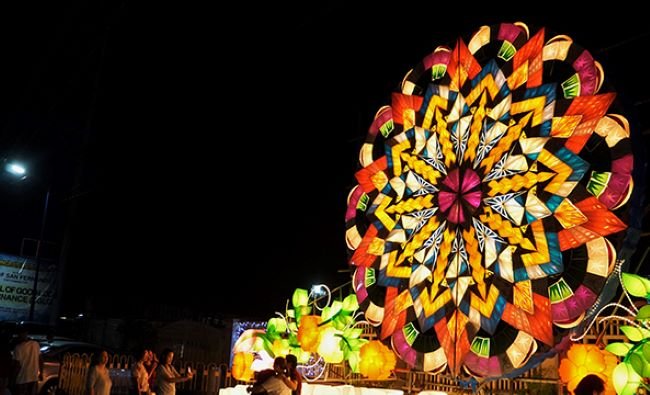
By the 1830s, they had more varied colors and shapes, including elaborate fold-cut paper patterns. Since every lantern was handmade, each home had a unique design. Also, lamb-shaped parols symbolize the Lamb of God, and a dove symbolizes the Holy Spirit. Additionally, the parol’s shape resembles nativity scene animals moving close to parols in the shape of angels. However, they are hardly frequently used now.
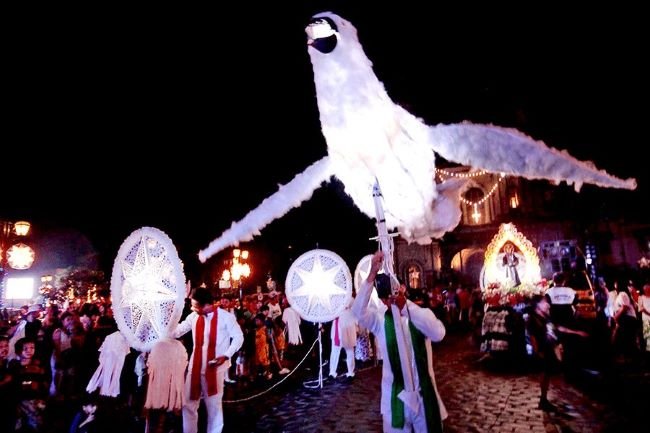
The design from the 1900s until the present
Meanwhile, it took until the American colonial era for the parol to develop its typical five-pointed star shape. According to oral accounts, in 1908, a Pampanga craftsman called Francisco Estanislao created the first parol with a five-pointed star. He made his pattern out of bamboo strips covered with Japanese paper lit by a candle called a “kalburo” (carbide lamp).
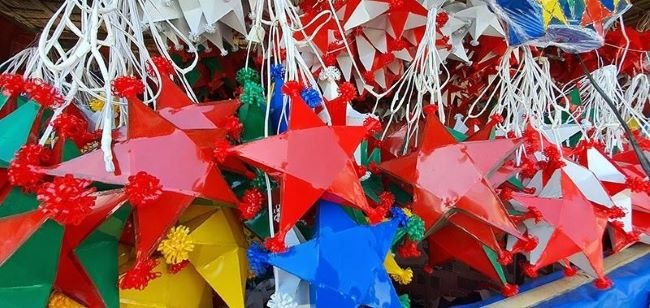
With the introduction of electricity in Pampanga, light bulbs took the place of candles. Meanwhile, during the 1940s invented the first battery-powered lamps with incandescent bulbs.
Soon, dancing lights arrived; initially, several switches were used to manually control them. Eventually, the inventor of lanterns Rodolfo David created parols with rotor systems in 1957. The “rotor” is a device that made it possible for the lights to function as the designer had intended. To program the lighting and music, David used revolving steel drums with wires on hairpins. Introduced in 1964, this served as the model for the commercial electric parols known as Parul Sampernandu.

Celebrate Holidays at the Casa
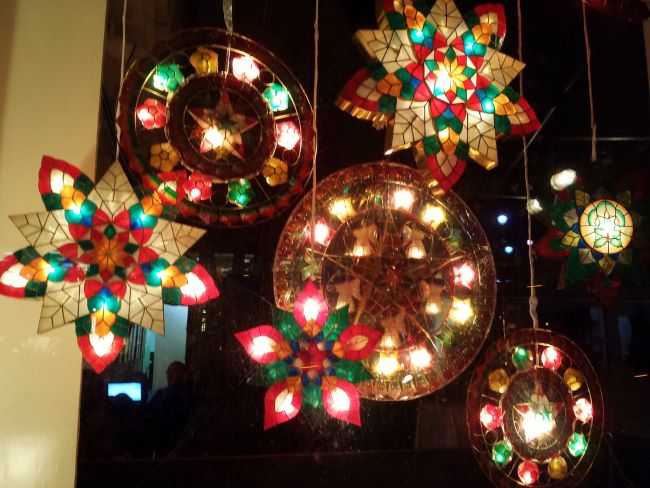
The lantern changed over time into a more elaborate, elegant, and brilliantly lighted Christmas decoration. Along with the typical parol design, other materials like capiz shells with elaborate lighting also gained popularity. The lantern furthers the concept of parol by showcasing Filipino craftsmanship. Made of anything from shells to plastic to fiberglass, modern Christmas lantern possess eye-catching patterns and captivating light displays.
In the modern times
The parol continues to be associated with the Simbang Gabi ceremony as it was originally. To celebrate the Three Kings and their visit to the baby Jesus, it is kept until January and usually removed after Epiphany .
The Philippines, which has numerous festivals and parades including parols across the nation, is argued to be the Christmas Capital of Asia. The Ligligan Parul sometimes referred to as the Giant Lantern Festival, is the most well-known held in San Fernando City. Different barangays create lanterns as tall as 20 feet for this annual competition. The brass band playing in the background is used to “dance” these giant parols. Every year, the competition begins just before the first Simbang Gabi mass.
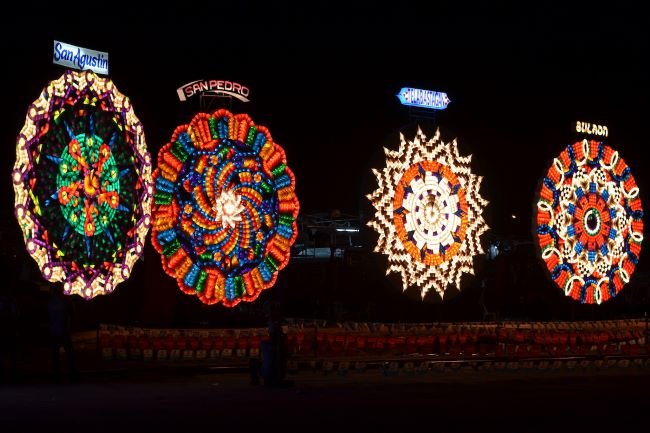
Lantern Parade at the University of the Philippines is arguably more well-known to those who reside in Manila. It departs from the standard San Fernando parol and instead includes floats of various shapes which are illuminated and exhibited all throughout the institution. The more conventional five-point star parol gains relevance thanks to Las Pinas’ own Parol Festival. As Miss Universe 2018 Catriona Gray displayed parol in her National Costume, parol even gained attention on an international stage.

With this in mind
The parol has come to be recognized as a symbol of Filipino Christmas. It serves the same purpose for Filipinos that the Christmas tree does for cultures in the West. Given the parol, it is not surprising that the Christmas season is merry and bright in the Philippines. Christmas lanterns made by Filipinos are a tradition, a work of art, and a timeless symbol of the holiday. Even in the darkest times, Filipinos regard parol as a symbol of hope.
There has been a deep reason or symbolism for the parol’s existence throughout its rich heritage. It not only represents the birth of Jesus Christ but also the triumph of light over darkness, which is the actual meaning of Christmas. It also represents the Filipinos’ renowned creativity. That is why you should hang the most elegant, colorful, and stunning parol during the ‘ber’ months.

“Ber” Month Tradition – Why do Filipinos start celebrating Christmas in September?

Manaoag Church: The Sacred Beauty of Pangasinan

7 Must-Try Food in Bangkok Thailand

Bangkok: A Flavorful Journey Through Culture and Cuisine

Why Antoinette Jadaone’s Sunshine is a film to watch out for

Lakbay Norte: 5 Must-Visit Places in Tarlac Province

Who Are the 9 National Heroes of the Philippines?
encyclopedia .design
Luminous Heritage: The Parol and Its Resplendent Journey in Filipino Christmas Tradition

A unique and vibrant symbol of celebration lights up the Philippines—the Parol. This traditional Filipino lantern has a rich history and cultural significance. It embodies the festive spirit and communal joy of Filipino Christmas. In this deep dive, we explore the parol’s journey from a simple lantern to a cherished Filipino identity emblem. We investigate its design and material evolution. We also look at parol symbolism and its enduring significance in local and diaspora communities.
Historical Perspective: A Beacon of Welcome and Faith
The parol’s origins predate Spanish colonization and served as a symbol of hospitality for weary travellers. Initially a modest, paper-crafted light, it evolved through Spanish influence into a vital component of the nine-day Christmas Novena processions. The parol’s transformation into a star-shaped lantern, symbolizing the Star of Bethlehem, marks its standardization during the American colonial period. This evolution reflects the Philippines’ rich cultural tapestry, with the parol becoming an iconic symbol of Filipino Christmas, embodying the nation’s resilience and adaptability.
The Art and Craft of Parol Making
Traditional parols were handcrafted from bamboo and papel de japón, illuminated by candles or oil lamps. Today, this craft has embraced innovation, with materials ranging from capiz shells to plastic and metal and lighting shifting to electric and LED. The design complexity has also evolved from simple stars to elaborate patterns and figures, showcasing Filipino ingenuity and craftsmanship. The parol-making tradition, incredibly vibrant in Pampanga and known as the “Home of the Giant Lanterns,” highlights a community’s collective effort to celebrate and preserve their cultural heritage.

Illuminate Your Holiday Season with Filipino Traditions
Dive into the vibrant world of Filipino Christmas with Andrea Serviño’s debut coloring book, Filipino Christmas Lanterns and Traditions: A Coloring Book of Festivities, Creativity, and Parol Design . Experience the beauty and warmth of the Philippines during the festive season, as Serviño takes you on a global journey of the iconic Parol. From adorning walls in cozy homes to shining bright beneath the majestic Golden Gate Bridge, these lanterns symbolize the joyful spirit and rich culture of Filipino Christmas celebrations.
Symbolism and Use in Modern Celebrations
Parol symbolism remains a potent symbol of hope, faith, and unity among Filipinos. Its presence in homes, streets, and churches from September through January illustrates its integral role in Filipino Christmas celebrations. The tradition transcends geographic boundaries, with Filipinos worldwide displaying parols, thereby maintaining a tangible connection to their cultural roots. The annual Giant Lantern Festival in San Fernando, Pampanga, epitomizes the communal and competitive spirit of parol making, showcasing spectacular designs that blend tradition with modern technology.

Global Influence and Diaspora Traditions
The Filipino diaspora has introduced the parol to global audiences, integrated it into local celebrations, and shared its cultural significance with diverse communities. The parol is present at the Wiener Christkindlmarkt in Austria and at the Parol Festivals in the United States . It symbolizes Filipinos’ unity and shared identity. The parol bridges cultures and fosters mutual appreciation and understanding.
Conclusion: Illuminating the Filipino Spirit
More than a festive decoration, the parol is a beacon of the Filipino spirit—resilient, joyful, and inclusive. Its journey from a simple lantern to a complex cultural symbol reflects Filipino artistry and shows the dynamic nature of faith and tradition. As we celebrate Christmas, the parol reminds us of the light of hope and signifies the warmth of community. This light shines brightly across the Philippines and beyond.
More Filipino Design in the News

Filipino design has recently garnered significant international attention, reflecting the country’s rich cultural heritage and innovative spirit. Parol symbolism is a traditional Filipino representation of light and hope. It is often showcased in various design elements , further emphasizing the country’s unique cultural narratives.
Designers Shine at Paris Fashion Week
Filipino celebrities and designers made a notable impact during the Spring/Summer 2025 Paris Fashion Week. Heart Evangelista, a prominent figure, generated substantial media engagement, highlighting the global appeal of Filipino fashion . Vogue Business
‘Filipinxt’ Fashion Event in New York
In May 2024, New York hosted ‘Filipinxt,’ a fashion event dedicated to showcasing Filipino style and heritage. The event featured collections from designers like Bessie Besana and Veejay Floresca. Wilson Limon from NiñoFranco also showcased his work. Michael Leyva’s collection highlighted the fusion of traditional Filipino elements with contemporary fashion. BusinessMirror
’50 Years of Philippine Design and Beyond Exhibition
The National Museum of Fine Arts in Manila presented the ’50 Years of Philippine Design and Beyond’ exhibition. It celebrated five decades of Filipino design across various disciplines. These include fashion, furniture, and graphic arts. The exhibition highlighted the evolution and global influence of Filipino design. Adobo Magazine
Sustainable Design Initiatives
Filipino designers are increasingly focusing on sustainability. Brands like Marricola, founded by Mariel Colaljo, create luxury bags from upcycled plastics, blending traditional craftsmanship with eco-friendly practices. Similarly, Bambike produces bicycles using locally sourced bamboo, promoting environmental consciousness and supporting local communities. Vogue Philippines
Cultural Fusion in Interior Design
Mary Josephine Paaske, Miss Universe Philippines Cebu Heritage 2024, is making significant progress in interior design . She is blending Scandinavian and Filipino styles. Her work aims to introduce Filipino cultural elements into Danish design landscapes, fostering cross-cultural appreciation and innovation. Scandasia
These developments underscore Filipino design’s dynamic and evolving nature. Parol symbolism is a recurring theme, and they highlight its growing influence on the global stage.
Parol. (2024, February 13). In Wikipedia . https://en.wikipedia.org/wiki/Parol
More on Art and Design

Exploring Belle Époque Poster Art
The Belle Époque , marked by cultural flourishing in Europe, saw the rise of poster art that combined commerce and creativity,…

Understanding Trompe l’œil: The Art of Deception
Trompe l’œil is an art technique creating three-dimensional illusions on flat surfaces, utilizing detail, perspective, and shading to engage viewers…

The $500,000 Spill: William Sokolin and the Case of the 1787 Chateau Margaux
William Sokolin’s 1989 mishap with a rare 1787 Chateau Margaux, valued over $500,000, highlighted the complex relationship between wine rarity,…
Something went wrong. Please refresh the page and/or try again.
- Click to share on Facebook (Opens in new window)
- Click to share on LinkedIn (Opens in new window)
- Click to share on Pinterest (Opens in new window)
- Click to share on Twitter (Opens in new window)
- Click to share on Reddit (Opens in new window)
- Click to share on Tumblr (Opens in new window)
- Click to email a link to a friend (Opens in new window)
- Click to print (Opens in new window)
Leave a Reply Cancel reply
This site uses Akismet to reduce spam. Learn how your comment data is processed .
© 2024 Encyclopedia Design. All rights reserved.
Discover more from Encyclopedia of Design
Subscribe now to keep reading and get access to the full archive.
Type your email…
Continue reading

Essay on Filipino Christmas
Students are often asked to write an essay on Filipino Christmas in their schools and colleges. And if you’re also looking for the same, we have created 100-word, 250-word, and 500-word essays on the topic.
Let’s take a look…
100 Words Essay on Filipino Christmas
The spirit of filipino christmas.
In the Philippines, Christmas is a much-loved holiday. It is a time for family, food, and fun. Christmas season starts as early as September and ends in January. This makes it the longest Christmas celebration in the world.
Simbang Gabi
A unique tradition is the ‘Simbang Gabi’ or Night Mass. It starts nine days before Christmas. People wake up early and go to church to pray. It is believed that if you attend all nine masses, your wish will come true.
Parol Lanterns
Another tradition is the ‘Parol’. It’s a star-shaped lantern made from bamboo and paper. It symbolizes the Star of Bethlehem. These lanterns light up homes, streets, and towns.
Noche Buena
On Christmas Eve, families gather for ‘Noche Buena’, a grand midnight feast. The table is filled with delicious food like lechon (roasted pig), ham, and rice cakes.

Gift-Giving
Gift-giving is also a big part of Filipino Christmas. Children often receive ‘aguinaldo’ or gifts from their godparents and elders. It’s a way of showing love and blessings.
In conclusion, Filipino Christmas is a time of joy, love, and sharing. It’s a unique celebration filled with traditions that bring families closer together.
250 Words Essay on Filipino Christmas
What is filipino christmas.
Filipino Christmas is a special time in the Philippines. It starts in September and ends in January, making it the longest Christmas season in the world. It is filled with lots of joy, love, and traditions that bring families together.
Unique Traditions
One of the most loved traditions is the “Simbang Gabi”. It is a series of nine dawn masses that start on December 16 and end on Christmas Eve. People believe that if you attend all nine masses, your wish will come true. Another tradition is the “Parol”. It is a star-shaped lantern, which is a symbol of the Christmas star.
Food in Filipino Christmas
Food plays a big role in Filipino Christmas. Families prepare a feast called “Noche Buena” on Christmas Eve. Some popular dishes are lechon (roasted pig), bibingka (rice cake), and puto bumbong (purple rice dessert).
Gift-Giving and Caroling
Gift-giving is also an important part of Filipino Christmas. Children visit their godparents to pay respect and receive gifts. Caroling is another tradition where children sing Christmas carols in front of houses in exchange for coins or treats.
Filipino Christmas is a time of joy and sharing. It is filled with traditions that make it unique and special. It is a time when families come together to celebrate, share food, and spread love. It truly is a magical time in the Philippines.
500 Words Essay on Filipino Christmas
Introduction to filipino christmas.
Christmas is a special time in the Philippines. It is the most awaited and longest holiday season in the country. The season starts as early as September and lasts until the first Sunday of January. This unique tradition is a reflection of the Filipinos’ deep faith and love for family gatherings.
The Simbang Gabi Tradition
One of the most important traditions during Christmas in the Philippines is Simbang Gabi. It is a series of nine dawn masses that start on December 16 and end on December 24. The masses are held very early in the morning, usually at around 4 or 5 AM. Many Filipinos believe that if you attend all nine masses, your wish will come true.
Parol: The Symbol of Filipino Christmas
When you talk about Filipino Christmas, one thing that comes to mind is the ‘Parol’. It is a star-shaped lantern, usually made from bamboo and paper, and is a symbol of the Star of Bethlehem. Parols are hung outside homes and along the streets, lighting up the whole country during the Christmas season.
Christmas Eve Feast: Noche Buena
On Christmas Eve, Filipinos gather for the Noche Buena, a grand family dinner. The table is filled with various dishes, like lechon (roasted pig), hamon (Christmas ham), queso de bola (Edam cheese), and sweets like bibingka and puto bumbong. This feast is a time for families to share a meal and enjoy each other’s company.
Carol Singing
Another popular tradition is carol singing. Children go from house to house singing Christmas carols. In return, they receive gifts or money. This tradition brings joy and spreads the Christmas spirit in the community.
Gift-Giving: Monito Monita
Gift-giving is a big part of Filipino Christmas. A fun tradition called Monito Monita is similar to Secret Santa. People draw names to determine who they will secretly give gifts to during the Christmas season. The reveal is made during the Christmas party, adding to the festive mood.
Conclusion: The Spirit of Filipino Christmas
Christmas in the Philippines is a time of faith, joy, and family. The long celebration, the vibrant traditions, and the warm gatherings all reflect the true spirit of Filipino Christmas. It is a season filled with love, sharing, and a lot of good food. The Filipino Christmas is a unique blend of local and foreign traditions that truly makes it one of a kind.
That’s it! I hope the essay helped you.
If you’re looking for more, here are essays on other interesting topics:
- Essay on Filipino
- Essay on Fighting Depression
- Essay on Fight For Justice
Apart from these, you can look at all the essays by clicking here .
Happy studying!
Leave a Reply Cancel reply
Your email address will not be published. Required fields are marked *
Save my name, email, and website in this browser for the next time I comment.
Christmas Parol: A Colorful And Traditional Christmas Symbol In The Philippines

The Christmas parol is considered the greatest expression of the Christmas spirit in the Philippines. It signals the beginning of the Christmas season for the country. What is a Christmas parol? In the Filipino language, the word parol means lantern. The traditional parol is a five point star-shaped Christmas lantern which has been a time-honoured Christmas symbol in the Philippines.
You see parols hanging in every street and road of towns and cities, outside almost every Filipino home, in schools and office buildings, shopping malls, and even churches during the entire Christmas season which usually starts as early as November. As a traditional Christmas symbol for every Filipino, the Christmas parol is a reminder of the star of Bethlehem. It symbolizes the guiding light of the Three Wise Men to the manger of the Child Jesus.
There is no other Christmas symbol in the Philippines that exudes more warmth than these Christmas lanterns called parol. These Christmas lanterns are very unique to the Philippines. Parol-making is a traditional folk craft of Filipinos. It is even taught to school children.
Schools hold lantern parades every year to showcase the artwork of these students. The original parols were made from very simple materials. The star-shaped frames were made of thin bamboo covered with colored cellophane or Japanese paper (rice paper) and crepe paper. Underneath were two tails that served as the rays of the star. Either a candle or a coconut oil lamp was used for illumination.

Today, these Filipino Christmas lanterns called parol come in many different shapes, sizes, and materials. It need not be star-shaped anymore. The parols can either be round, rectangular, or even square with the Nativity scene in it. Some special shapes like flowers, Santa Clause and angel are also being designed and made today. However, the basic concept remains the same. The traditional star-shaped lanterns have even evolved into parols made of Capiz shell or plastic.
Wrought irons have replaced the traditional bamboo stick frames. Meticulously designed modern Philippine Christmas lanterns use layers of these materials with different stickers. This creates an impression of depth and contrast despite having only one source of light coming from inside the lanterns themselves. Not only have the frames and materials evolved. The candle and the coconut lamp that used to illuminate the star have evolved too. The parol's have been made even more colorful by using colorful blinking bulbs in a kaleidoscope of patterns. Indeed, these innovations from the traditional parol showcase the ingenuity, creativity and artistic talent of the Filipinos.

History of Chrismas Parol and the Philippine Christmas Celebration
Parol, which is pronounced as pah-roll with a rolling “r”, came from the Spanish word “farol” which means lantern. The World Book’s Christmas in the Philippines wrote that the origin of parol can be traced from the Mexican pinata. Originally, the pinata came to Spain from Italy in the 1300’s. Later, it spread to Mexico. It was, however, the Spaniards who brought the concept of pinata to the Philippines when they brought Christianity in the country.
The book “A Child’s Pasko: Christmas in the Philippines” wrote that the first parols where made to be used as lanterns to light the way to the church for the Misa de Aguinaldo or Gift Masses that were held everyday. During those times, the church started to hold these masses on December 16 until the midnight of December 24.
The Christmas mass celebration on December 16 marked the beginning of the Christmas season in the Philippines. On the other hand, the midnight mass on Christmas Eve, called Misa de Gallo or Mass of the Rooster, marked the culmination of the Christmas celebration. The Christmas eve mass is later followed by a sumptuous meal shared by the whole family. This Christmas eve meal, called Noche Buena, was most awaited part of the celebrated by children. This Christmas tradition is still being observed by Filipino families up to today.
Stories about parol as told by old folks say that they would hang their parols outside their windows after coming home to church to display their work of art. Their parols are lighted with candles or coconut oil lamps, so that villagers who would walk around can appreciate the works of others. Every Filipino household would make their parol with better design each year and even outdo those of their neighbors. Later, this friendly competition was encouraged by the church. Spanish priests offered incentives for people who created the best parol. It was them when the parols were viewed as devotional offering of the Filipino families to Jesus.

Parol- Making as a Symbol of Hope
Over the years, the popularity of parol has not only made it the most recognizable Christmas symbol for the Filipinos. These Philippine Christmas lanterns also became the symbol of hope to many parol makers. Many Filipinos have made parol-making business as a source of income.
They begin to make their parols as early as June of each year and start to sell them in the market starting in October. Parol stores and parol vendors are seen along strrets and highways and even shopping malls. In fact, because of the intricacy of the parol designs today, parols are already being sold overseas. These export quality Christmas lanterns are usually made of capiz shells and can be re-used every year. There are even parols that are being sold online.
Parol as a Festival of Lights
Parol as a major part of the Philippine Christmas celebration has become a festival of lights. Homes, businesses, streets, and parks are brightly lit with spectacular displays of beautiful and colorfully blinking parols. One must travel at night everywhere in the city starting on December 16 until January 6 to see the peak of this Festival of Lights in the Philippines.

The most lavish and spectacular parade of parols or Philippine Christmas lanterns is held every year in San Fernando, Pampanga in Luzon. As much as twenty feet parols in the most unique shapes, colors and sizes made from all kins of materials paraded around the streets on truck beds. This Giant Lantern Festival has become the event that the province of Pampanga is known for. Local and foreign tourists marvel at the parade of wonderful parols with kaleidoscopic blinking lights.
The parols of today do not just represent the innovation, artistry and creativity of the Filipinos. For the Filipinos, parol-making, decorating and lighting a parol also signifies shared faith and hope. That is why Christmas Parol is the most recognizable Christmas symbol for Filipinos not just in the Philippines but in every country where there is a Filipino family and community.


Parol: The Filipino Christmas Lantern
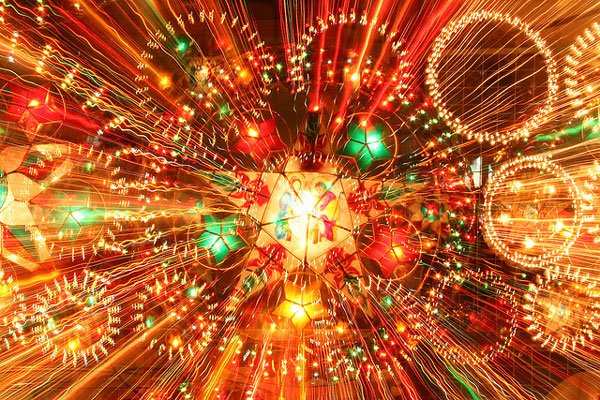
Filipinos call the local version of the Christmas lantern “parol”. The traditional lantern is a five-point star made of bamboo sticks and colored Japanese paper or cellophane. Originally, people place a lighted candle inside during nighttime but due to fire accidents, they switched to LED twinkling lights.
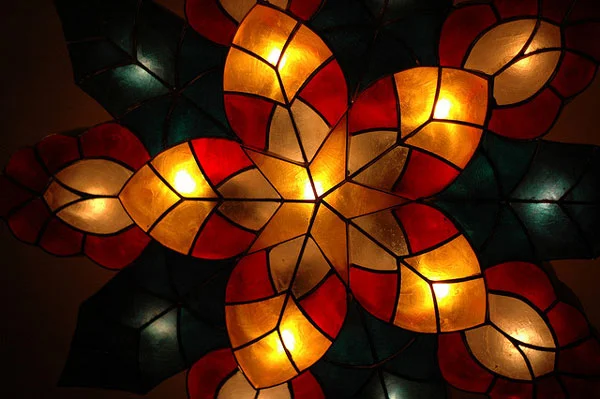
The parol represents the star of Bethlehem that the Three Kings used as their guide on their way to find the Child Jesus. Filipinos often hang it outside of windows, in balconies and over a belen. They either buy a parol or have the children of the family make it.
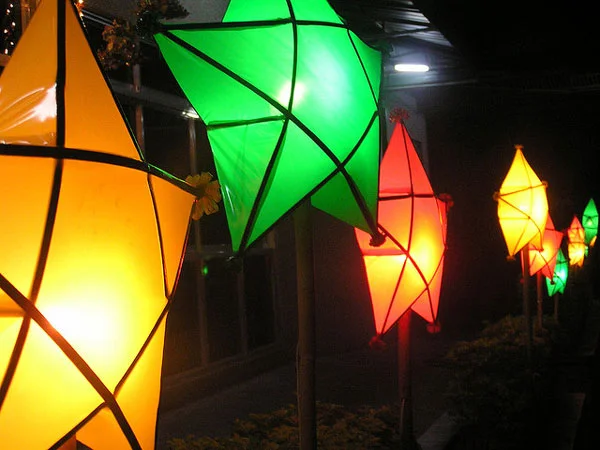
The parol has evolved over the years and one can find a wealth of different designs. They now range from intricate giants made of Capiz shells to simple stars fashioned from recycled material. Schools, church groups and companies hold contests to encourage the participants’ creativity in making the iconic star. They also promote the use of recycled and indigenous materials.

Above all, the Giant Lantern Festival in San Fernando, Pampanga is the best showcase of the modern parol. There are no simple stars in the festival, nor are there small ones. The festival, also known as Ligligan Parul, is a competition for the biggest and brightest.
Modern technology is often used in making the parols for the festival. Makers use software to program the light sequence and colors to make sure they “dance” to the tune of a pre-selected Christmas song. Don’t forget to bring a camera if you’re planning to witness this event.
For Filipinos living aboard, the parol represents a piece of home. They still hang it outside their homes, a signal that within lives a festive Filipino family. The parol remains the star that leads believers home.
About the Author

Adelle is a fun-loving Filipina who seeks adventures with her daughter Adie and her husband Jun. She writes about her weekend escapades and food adventures in and around her beloved Davao City at Philippine Traveler . She also chronicles her discoveries on the Philippine Traveler YouTube channel .
Recent Posts
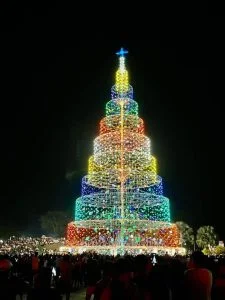
The Tallest Christmas Tree in the Philippines
Right about now, Christmas trees are sprouting all over the world. It’s almost Christmas — the most wonderful time of the year! In the Philippines,

Best Christmas Gift for New Parents
Becoming a new parent is a surreal experience. All the firsts are committed to memory, especially the baby’s first holiday. Getting the best Christmas gift

New Year Superstitions in the Philippines
Filipinos are very superstitious people. For every life event, there is a superstition in play. While living modern lives, Filipinos still live by deeply-ingrained superstitions,
Get Your Copy of the Christmas in the Philippines eBook for FREE!
Get your copy of the Christmas in the Philippines ebook and relive the spirit of the Filipino Christmas wherever you are in the world. The book will be your guide to traditions, recipes, holiday destinations and even decor DIYs for the seasons.
Brought to you by

©2024 Christmas in the Philippines. All Rights Reserved. Contact | Privacy Policy | Sitemap
Download Your Free Filipino Christmas Package
These downloads are free but available only to our Philippine traveler community. Simply register below, and we’ll redirect you to your free downloads.
Your information is secure and will not be sold.

Filipinas Kong Mahal

- American Colonial Period (1901-1946) (90)
- Ancient Monarchs and Leaders in the Philippines (5)
- Contemporary Period (1986-Present) (57)
- Filipino Culture and Heritage (118)
- Japanese Occupation (1942-1945) (4)
- Martial Law and Fourth Republic (1972-1986) (14)
- Philippine mythological creatures (5)
- Post Marcos (5)
- Post-War Era and Third Republic (1946-1972) (26)
- Pre-Colonial (900–1560) (62)
- President of the Philippines (17)
- Questions Asked (90)
- Spanish Colonial Period (1521-1898) (54)
Philippines Christmas Parol
Did you know that every Christmas season in the Philippines, millions of ornamental lanterns called Christmas Parols adorn homes, streets, and communities? The Parol, a symbol of Filipino Christmas tradition , brings a sense of joy and warmth to the holiday festivities. This unique festive decor holds deep cultural and historical significance, reflecting the country’s faith, resilience, and hope.
Explore the enchanting world of the Christmas Parol as we delve into its history, construction, symbolism, and the grand festivals that showcase its beauty and creativity. Discover how this cherished symbol illuminates the spirit of Filipino Christmas celebrations , and even learn how to make your own Parol to embrace this vibrant tradition.
History of the Parol: From Pre-Spanish Times to Present Day
The parol has a rich history that dates back to pre-Spanish times in the Philippines. In ancient Filipino culture, lanterns were a significant symbol of hospitality, representing a warm welcome and an invitation for travelers to seek shelter in homes. The parol, with its beautiful and unique design, became closely associated with the Christmas season during the Spanish colonial period.
The parol played a vital role in traditional Filipino Christmas traditions such as the Panunulúyan pageant and the Simbang Gabi procession. These festivities featured the parol as an essential part of the decorations, illuminating the streets and guiding the way for celebrations.
Over time, the design of the parol evolved. Initially, lanterns were rectangular or oblong in shape, but they later transitioned into the iconic five-pointed star design, symbolizing the Star of Bethlehem . Francisco Estanislao is credited with crafting the first five-pointed star-shaped parol in 1908, solidifying the star design as the standard for parols.
Traditionally, parols were made using white paper, but by the 1830s, they became more diverse in shape and color. Today, parols are crafted using a wide variety of materials, including bamboo, plastic, metal, and capiz shells . They come in various sizes, from small ornaments to large 20-foot displays, offering endless possibilities for designs and creativity.
“The parol’s captivating history showcases its evolution from a symbol of hospitality to an iconic representation of Filipino Christmas traditions.”
The parol continues to hold immense significance and remains an important part of Filipino Christmas celebrations . Its history reflects the culture, heritage, and faith of the Filipino people, serving as a timeless symbol of hope, joy, and the triumph of light over darkness.
Parol History Timeline:
Construction and design of the parol: traditional and modern variations.
Parols are traditionally constructed using bamboo sticks and papel de japon (Japanese paper). The most common form is a star-shaped lantern with five points and two decorative “tails.” This classic design represents the Star of Bethlehem and is a symbol of hope and guidance during the Christmas season.
However, modern parols have evolved to incorporate a wide range of materials, allowing for endless design possibilities. In addition to bamboo and papel de japon, parols can now be made using plastic, shells, glass, beads, foil, feathers, hemp, leaves, seeds, plastic straws, wood, and metal.
One of the most distinctive features of modern parols is the intricate use of capiz shells . Capiz shells are translucent oyster shells native to the Philippines, and they add a unique and captivating element to the design. The delicate nature of the shells allows light to pass through, creating a beautiful and ethereal glow.
Design and Size Variations
Parols come in various shapes and sizes, catering to different tastes and preferences. While the traditional star-shaped lantern remains popular, parols can also feature shapes such as angels, flowers, Santa Claus, and Christmas trees. The versatility of parol design allows individuals to personalize their festive decor and showcase their creativity.
Size is another aspect that varies widely in parol construction . From small ornaments that can be hung on Christmas trees to large outdoor displays that reach twenty feet or more, parols can make a statement in any setting. The size of a parol often depends on its purpose, with smaller ones serving as decorative accents and larger ones becoming eye-catching focal points of festive displays.
“The diversity in construction and design of parols ensures that there is a parol for everyone, whether you prefer a traditional star-shaped lantern or a more modern and unique design.”
Whether traditional or modern in design, parols continue to be an integral part of Filipino Christmas celebrations . Their construction and design reflect the rich cultural heritage of the Philippines and add a touch of beauty and festivity to homes, streets, and communities during the holiday season.
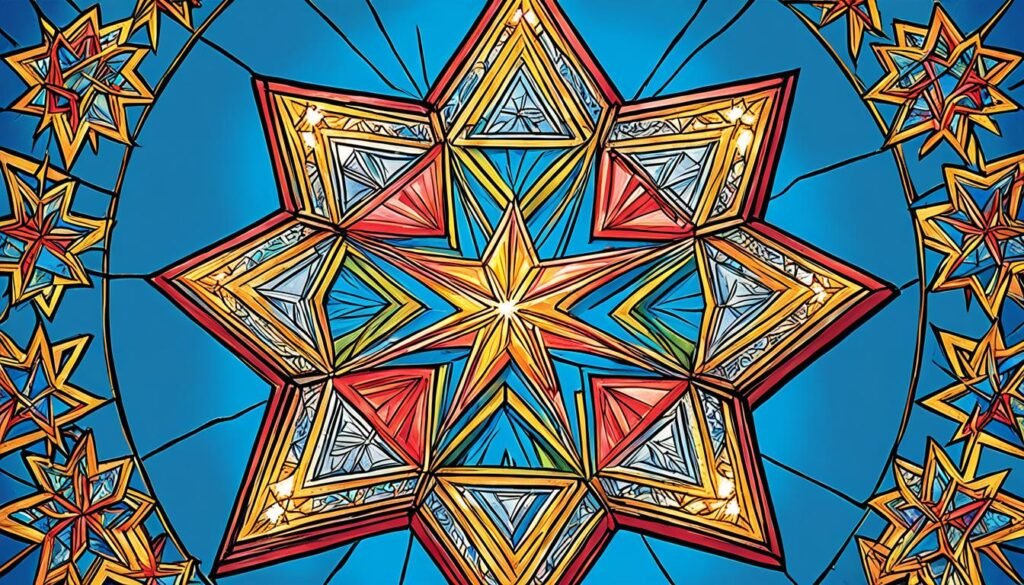
Symbolism and Meaning of the Parol: The Triumph of Light over Darkness
The parol, a traditional Filipino ornamental lantern, holds deep symbolism and meaning in Filipino Christmas celebrations. It goes beyond being a mere festive decoration and represents the triumph of light over darkness, joy, and hope.
The star-shaped design of the parol is particularly significant as it symbolizes the Star of Bethlehem . Just as the star guided the Three Kings to the manger where Jesus was born, the parol serves as a guiding light, leading us towards faith and the promise of a better tomorrow.
“The parol represents the triumph of light over darkness, joy, and hope.”
During the Christmas season, the parol’s presence serves as a reminder to remain resilient and optimistic, even in the face of challenging times. It is a symbol of faith and serves as a beacon of hope in the midst of despair. The vibrant and illuminated parols scattered throughout Filipino communities provide a sense of warmth, unity, and joy.
The parol is not taken down immediately after Christmas. It continues to shine its light until the Feast of the Epiphany in January, honoring the visit of the Three Kings. This tradition reminds us to hold onto the spirit of Christmas and carry the message of hope throughout the year.
Parol Festivals and Competitions: Showcasing Beauty and Creativity
Parol festivals and competitions are an integral part of Filipino Christmas celebrations. These events bring together individuals, villages, schools, and groups to compete and showcase their creativity in designing and creating stunning parols. The festivals highlight the artistry and craftsmanship of Filipino culture, while also providing a platform for showcasing the beauty of these traditional lanterns .
One of the most renowned parol festivals in the Philippines is the Giant Lantern Festival , held annually in San Fernando, Pampanga. This festival draws participants from all over the country who strive to create the most magnificent and visually captivating parols. The lanterns featured in this competition are towering structures adorned with thousands of lights, casting a mesmerizing glow over the festive atmosphere.
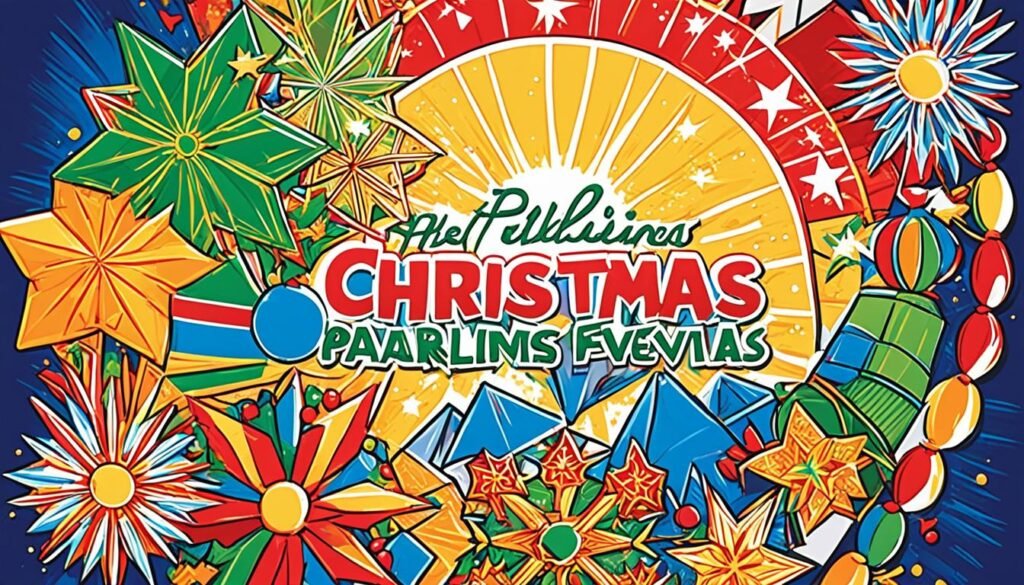
This grand event not only serves as a celebration of creativity but also as a source of pride for the local community. The Giant Lantern Festival is a testament to the Filipino people’s deep appreciation for their cultural heritage and the significance of parols in the Christmas traditions.
“The Giant Lantern Festival is a celebration of the spirit of Christmas in the Philippines. It showcases the immense talent, dedication, and ingenuity of our people in creating these magnificent parols that bring joy and wonder to all who behold them.”
Aside from the Giant Lantern Festival, various other communities across the country organize their own parol festivals and competitions. These local events provide an opportunity for individuals, families, and communities to come together and appreciate the beauty and diversity of parol designs.
Table: Different Parol Festivals and Competitions in the Philippines
These competitions not only showcase the artistic talent of the participants but also contribute to the preservation and promotion of Filipino cultural heritage . Through parol festivals and competitions, the beauty and creativity of the Filipino people shine brightly, spreading joy and awe-inspiring wonder during the festive Christmas season.
Making Your Own Parol: A Step-by-Step Guide
Making your own parol is a fun and creative activity that allows you to embrace the Filipino Christmas tradition and personalize your festive decor . Follow this step-by-step guide to create your DIY parol .
- Bamboo sticks
- Rubber bands
- Colored tissue paper
- All-purpose glue
- Take the bamboo sticks and arrange them in the shape of a five-pointed star.
- Secure the sticks together by tying them with rubber bands at the intersections.
- Apply glue to the frame.
- Carefully place the colored tissue paper over the frame, adhering it to the glue.
- Continue covering the entire frame with tissue paper, ensuring a vibrant and decorative look.
- Cut colored paper strips of varying lengths.
- Attach the paper strips to the bottom of the parol using a glue gun.
- These tails add flair and enhance the overall festive appearance of the parol.
Once you’ve completed these steps, your DIY parol will be ready to illuminate your Christmas celebrations. Hang it in a prominent location to showcase your craftsmanship and bring a touch of Filipino tradition to your home.
The Importance of the Parol in Filipino Christmas Celebrations
The parol holds immense significance in Filipino Christmas celebrations. It is more than just a decorative item; it serves as a tangible symbol of Filipino culture and heritage. The parol represents the unique fusion of indigenous, Spanish, and American influences in Filipino Christmas traditions.
With its origins dating back to ancient times, the parol carries the essence of Filipino cultural identity. It reflects the country’s deep-rooted faith, resilience, and hope in the face of adversity. The parol’s radiance and vibrant colors bring joy and warmth to communities during the holiday season, fostering a shared cultural experience.
The parol is not just a lantern; it is a reflection of our traditions, our stories, and our values. It reminds us of the true meaning of Christmas and our commitment to each other as a community.
As a significant element of Filipino Christmas celebrations, the parol strengthens the bonds of family and community. It creates a sense of unity as families and neighbors come together to create and display their parols. The shared experience of making and admiring these beautiful lanterns builds connections and promotes the preservation of cultural heritage.
Cultural Resilience and Festive Spirit
The parol embodies the spirit of cultural resilience. It has seen the Philippines through many challenges and historical periods, standing as a symbol of hope and a testament to the Filipino people’s ability to adapt and withstand adversity. Through wars, natural disasters, and societal changes, the parol has remained a constant presence, illuminating the Christmas season with its enduring beauty.
“The parol is a celebration of our cultural heritage, a reminder of our strength, and a symbol of the traditions that define us,” says renowned Filipino artist Juan dela Cruz.
Preserving Tradition in Modern Times
In the midst of technological advancements and global influences, the parol preserves the essence of Filipino Christmas tradition . Its enduring popularity has led to numerous parol festivals and competitions across the country, where skilled artisans showcase their creativity and craftsmanship.
“The parol serves as a bridge between our past and our future. It allows us to honor our ancestors while embracing modern design and materials,” says cultural historian Sofia Santos.
The parol’s significance in Filipino Christmas celebrations goes beyond its visual allure. It represents the spirit of generosity, compassion, and togetherness that defines the holiday season. It is a reminder to cherish the company of loved ones and to spread joy and goodwill to others.
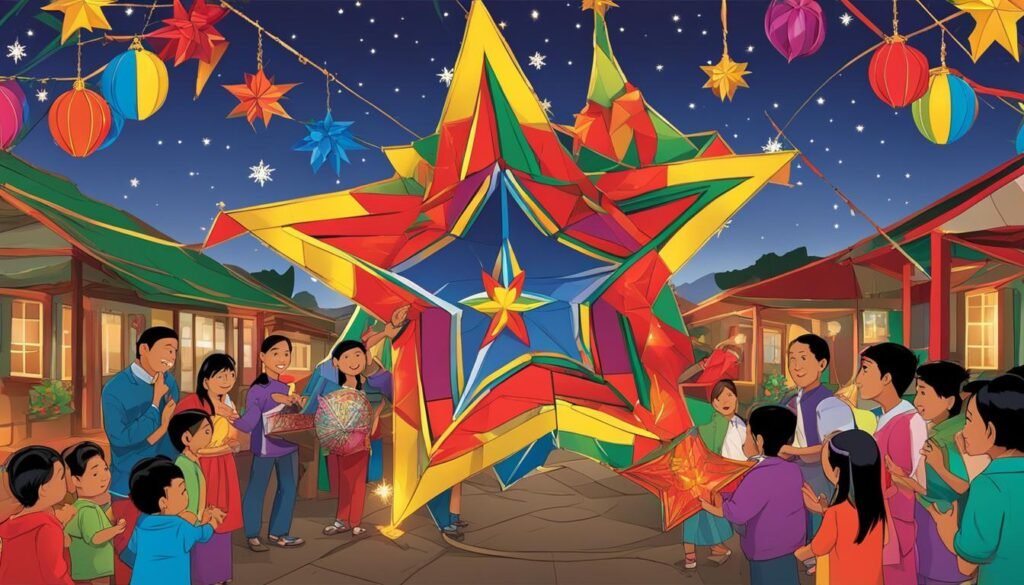
In the next section, we will explore how to create your own parol and contribute to the rich tapestry of Filipino Christmas traditions.
The Christmas parol is a cherished symbol of the holiday season in the Philippines. Its star-shaped design and festive illumination bring joy and warmth to homes, streets, and communities. The parol represents the triumph of light over darkness and serves as a reminder of hope, joy, and faith during the Christmas season. Whether traditional or modern in design, the parol holds deep cultural and historical significance, reflecting the unique spirit and traditions of Filipino Christmas celebrations. Embracing the parol tradition allows for a meaningful and festive holiday experience rooted in Filipino culture.
What is a Christmas Parol?
A Christmas Parol is a traditional Filipino ornamental lantern displayed during the Christmas season. It is typically made with bamboo and Japanese paper, and illuminated with candles, oil lamps, or carbide lamps. Modern parols can be made using other materials such as plastic, metal, and capiz shells, and are usually illuminated with electric lighting.
What is the significance of the Parol in Filipino Christmas traditions?
The Parol holds deep symbolism and meaning in Filipino Christmas celebrations. It represents the triumph of light over darkness, joy, and hope. The star-shaped design symbolizes the Star of Bethlehem that guided the Three Kings to the manger where Jesus was born. The Parol’s presence during the Christmas season is a reminder to remain resilient and optimistic, even in challenging times. It is a symbol of faith and serves as a beacon of hope in the midst of despair.
How are Parols constructed and what are the design variations?
Traditional Parols are constructed using bamboo sticks and Japanese paper, typically in a five-pointed star shape with decorative “tails.” However, modern Parols can be made with a wide range of materials, including plastic, shells, glass, beads, foil, feathers, and more. The design possibilities are endless, with Parols featuring various shapes such as angels, flowers, Santa Claus, and Christmas trees, alongside the traditional star-shaped lanterns.
What is the history of the Parol?
The tradition of the Parol predates the Spanish colonization of the Philippines. In ancient times, lanterns were a symbol of hospitality, indicating that travelers were welcome to seek refuge in homes with a Parol hanging in the window. The Parol became associated with the Christmas season during the Spanish colonial period, where it was part of the Panunulúyan pageant and the Simbang Gabi procession. The design of the Parol evolved over time, with rectangular or oblong shapes initially used, and later standardized to a five-pointed star symbolizing the Star of Bethlehem.
Are there any Parol festivals or competitions?
Yes, Parol festivals and competitions are an integral part of Filipino Christmas celebrations. One of the most famous events is the Giant Lantern Festival in San Fernando, Pampanga. This annual competition showcases towering lanterns illuminated by thousands of light bulbs. Other communities also organize Parol festivals and competitions where individuals, villages, schools, and groups vie for the title of the best Parol maker. These events highlight the artistry and craftsmanship of Filipino culture.
Can I make my own Parol?
Yes, making your own Parol is a fun and creative activity. To make a basic Parol, you will need bamboo sticks, scissors, rubber bands, glue gun, colored tissue paper, and all-purpose glue. The process involves creating a star-shaped frame with bamboo sticks, tying them together with rubber bands, and covering the frame with colored tissue paper using glue. Optional additions such as tails made from colored paper strips can be attached to the bottom of the Parol for added flair.
Why is the Parol important in Filipino Christmas celebrations?
The Parol holds immense importance in Filipino Christmas celebrations. It is not just a decorative item but a tangible symbol of Filipino culture and heritage. The Parol represents the unique blending of indigenous, Spanish, and American influences in Filipino Christmas traditions. It serves as a reminder of the country’s deep-rooted faith, resilience, and hope in the face of adversity. The Parol brings joy, warmth, and a sense of unity to communities during the holiday season, fostering a shared cultural experience and strengthening the bonds of family and community.
What is the cultural significance of the Parol?
The Parol is deeply rooted in Filipino heritage and serves as a cultural ornament during the Christmas season. Its star-shaped design and festive illumination bring joy and warmth to homes, streets, and communities. The Parol reflects the unique spirit and traditions of Filipino Christmas celebrations and symbolizes the country’s rich cultural diversity. It is a tangible representation of Filipino artistry and craftsmanship, showcasing the creativity and talent of the Filipino people.
Source Links
- https://en.wikipedia.org/wiki/Parol
- https://www.tatlerasia.com/lifestyle/arts/parol-the-christmas-décor-that-has-lit-the-world-in-2020
- https://www.washingtonpost.com/home/interactive/2023/filipino-parol-christmas-tradition/

IMAGES
COMMENTS
One of the most iconic symbol of Filipino Christmas spirit, is the Christmas lantern or locally known as “paról”. The star-shaped lanterns are displayed hanging outside the house, along the busy streets of the cities and even in provincial towns and small villages.
One of the causes is the Christmas lantern, also known as parol, which is the most iconic symbol of the Filipino Christmas spirit. Usually displayed outside of homes, along busy city streets, in tiny villages, and in provincial towns are these star-shaped lanterns. Photo Credits: Tatler Asia.
A unique and vibrant symbol of celebration lights up the Philippines—the Parol. This traditional Filipino lantern has a rich history and cultural significance. It embodies the festive spirit and communal joy of Filipino Christmas.
The usual and normal parol is a five point star-shaped Christmas lantern which has been a time-honoured Christmas symbol in the Philippines. The origin of parol can be traced back during the Spanish era in the Philippines, when the Spaniards brought Christianity to the islands.
When you talk about Filipino Christmas, one thing that comes to mind is the ‘Parol’. It is a star-shaped lantern, usually made from bamboo and paper, and is a symbol of the Star of Bethlehem. Parols are hung outside homes and along the streets, lighting up the whole country during the Christmas season.
These lanterns were hung outside of homes as decorations after the parade. They eventually developed into a crucial component of Filipino Christmas custom. In a letter written by José Rizal in 1893, he emphasizes the importance of the parol in the traditional Philippine Christmas celebrations.
Christmas parol, also known and the Christmas lantern, is a traditional Filipino symbol of the star of Bethlehem. It is the most recgnized Christmas symbol of faith and hope in the Philippines.
Parol: The Filipino Christmas Lantern. Filipinos call the local version of the Christmas lantern “parol”. The traditional lantern is a five-point star made of bamboo sticks and colored Japanese paper or cellophane.
A Christmas Parol is a traditional Filipino ornamental lantern displayed during the Christmas season. It is typically made with bamboo and Japanese paper, and illuminated with candles, oil lamps, or carbide lamps.
Today’s Christmas lanterns feature bold patterns and tantalizing light displays, made with all sorts of materials from shells to plastic, and even to fiberglass.